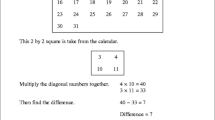Abstract
A mathematical problem is defined here as a question not dependent on specific syllabus content, and one sufficiently new to the student such that it cannot be solved by a previously known method. With increased attention being paid to this type of mathematical problem solving at the primary school level, the need for reliable and valid methods of assessment has become more apparent. This paper reports the results of using a new problem solving test, developed for use in the upper primary school, with 371 students in Years 4,5 and 6 at government schools in Melbourne. Particular attention is given to the effects of year level, sex and the method of test administration on student performance for different types of items and different problem solving processes. The performance of Year 4 students was generally lower than that of other students, but differences were small for most items and processes between Years 5 and 6. Although most of the differences in performance between the sexes were not significant, the girls had higher scores than the boys for the total score, for all processes and for all items except the spatial item. The method of administration was important for performance, especially for the girls. The marking schedule developed enabled high intra- and inter-marker reliabilities to be obtained.
Similar content being viewed by others
References
Bourke, S.F. (1977) “Student Background and Mastery in Reading and Numeration” in S. F. Bourke and J. P. Keeves (eds.)The Mastery of Literacy and Numeracy. Canberra: AGPS, 81–107.
Bourke, S. F., Mills, J. M., Stanyon, J. and Holzer, F. (1981)Performance in Literacy and Numeracy: 1980. Canberra: AGPS.
Clements, M. A. and Watanawaha, N. (1977) “Sex and Age-Within-Grade Differences in Mathematical Achievement of Victorian Children” in M. A. Clements and J. M. Foyster (eds.)Research in Mathematics Education in Australia, Vol. 2. Melbourne: Mathematics Education Research Groups of Australia.
Fennema, E. (1980) “Sex-related Differences in Mathematics Achievement: Where and Why” in L. H. Foxet al. (eds.)Women and the Mathematical Mystique. Baltimore: John Hopkins University Press, 76–93.
Stacey, K. (1987a) “Subject Variables Contributing to Problem Solving Performance”. Paper delivered to the 10th Annual Conference of the Mathematics Education Research Group of Australasia, Townsville.
Stacey, K. (1987b) “Mathematics Task Centre Attendance, Problem Solving Performance and Affective Factors”.Research in Mathematics Education in Australia, August, 1987, 33–40.
Stacey, K. and Bourke, S. (1987) “Testing Mathematical Problem Solving”. Manuscript submitted for publication.
Author information
Authors and Affiliations
Rights and permissions
About this article
Cite this article
Bourke, S., Stacey, K. Assessing problem solving in mathematics: Some variables related to student performance. Aust. Educ. Res. 15, 73–83 (1988). https://doi.org/10.1007/BF03219402
Issue Date:
DOI: https://doi.org/10.1007/BF03219402




